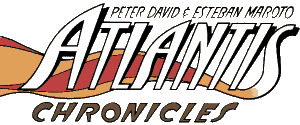
 The Atlantis Chronicles
(DC)
The Atlantis Chronicles
(DC)written by Peter David
drawn by Esteban Maroto
7-issue limited series
Rating:
![]() It's tempting to call this "The Secret Origin of Aquaman"... except for the fact that the waterbreathing member of the JLA appears only briefly in the whole series. It's also tempting to dismiss it as an attempt to reconcile the many mutually-inconsistent versions of "Atlantis" that have appeared in DC comics... except that it's far too ambitious and engaging for that. Finally it's tempting to not put the "superhero" tag on this review, but since the series deals heavily with folks who breathe water and sometimes even talk to fishes, I figure it's gotta stay.
It's tempting to call this "The Secret Origin of Aquaman"... except for the fact that the waterbreathing member of the JLA appears only briefly in the whole series. It's also tempting to dismiss it as an attempt to reconcile the many mutually-inconsistent versions of "Atlantis" that have appeared in DC comics... except that it's far too ambitious and engaging for that. Finally it's tempting to not put the "superhero" tag on this review, but since the series deals heavily with folks who breathe water and sometimes even talk to fishes, I figure it's gotta stay.
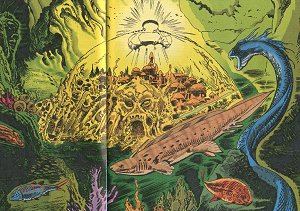
![]() The legend of Atlantis is an enticing one, including an ancient tale of an even more ancient but advanced civilisation lost forever, as well as the more modern notion of people living underwater. So it's been used a lot in fantasy literature, often in contradictory ways. Such has been the case just within the DC Universe. Sometimes the people of Atlantis were presented looking like ordinary humans (Aquaman being the most obvious example), other times they had fins and scales, still others they had fish tails like a "mermaid"). In some versions, they had high technology; in others they used magic. And while DC "cleaned up" this kind of inconsistency in other parts of their universe with Crisis on Infinite Earths, they apparently left "the Atlantis problem" mostly intact.
The legend of Atlantis is an enticing one, including an ancient tale of an even more ancient but advanced civilisation lost forever, as well as the more modern notion of people living underwater. So it's been used a lot in fantasy literature, often in contradictory ways. Such has been the case just within the DC Universe. Sometimes the people of Atlantis were presented looking like ordinary humans (Aquaman being the most obvious example), other times they had fins and scales, still others they had fish tails like a "mermaid"). In some versions, they had high technology; in others they used magic. And while DC "cleaned up" this kind of inconsistency in other parts of their universe with Crisis on Infinite Earths, they apparently left "the Atlantis problem" mostly intact.
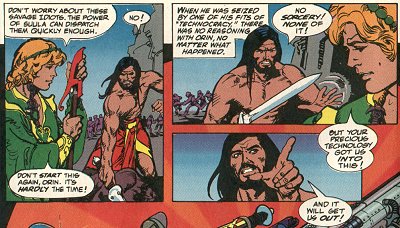
![]() Peter David took up the challenge of writing a history that explained it all, and did a surprisingly effective job of making it all make sense. He started by setting Arion aside: he came and went before all of this started. Then he sets up the story of a society torn: between science and magic, between two brothers leading in opposite directions, between divergent paths of social and biological evolution. Not only a solution to the contradictions, but the basis for an epic tale as well. It's a story told in the classic romantic tradition: of royal families, betrayals, bastard children, battles, and so forth. Imagine Malory's Morte D'Arthur set underwater.
Peter David took up the challenge of writing a history that explained it all, and did a surprisingly effective job of making it all make sense. He started by setting Arion aside: he came and went before all of this started. Then he sets up the story of a society torn: between science and magic, between two brothers leading in opposite directions, between divergent paths of social and biological evolution. Not only a solution to the contradictions, but the basis for an epic tale as well. It's a story told in the classic romantic tradition: of royal families, betrayals, bastard children, battles, and so forth. Imagine Malory's Morte D'Arthur set underwater.
![]() This series is composed to seven issues of 44 pages each (including a text page or two at the back of each), and attempts to summarise the history of Atlantis from before it sank into the sea before human recorded history, to the birth of the lad who would become Aquaman in the present.
This series is composed to seven issues of 44 pages each (including a text page or two at the back of each), and attempts to summarise the history of Atlantis from before it sank into the sea before human recorded history, to the birth of the lad who would become Aquaman in the present.
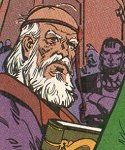
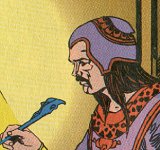


![]() The hook the series starts with is that each issue represents the events recorded by one of Atlantis' historians, first an old man loyal to one brother, then his middle-age nephew loyal to the other brother, followed by a teenaged girl, later by her son. This gives the tale an interesing "voice" as each of them views the events unfolding differently. David loosens this approach in the last few issues, however, as he starts skipping over periods of Atlantean history (which is just as well; we only have about 300 pages to work with here).
The hook the series starts with is that each issue represents the events recorded by one of Atlantis' historians, first an old man loyal to one brother, then his middle-age nephew loyal to the other brother, followed by a teenaged girl, later by her son. This gives the tale an interesing "voice" as each of them views the events unfolding differently. David loosens this approach in the last few issues, however, as he starts skipping over periods of Atlantean history (which is just as well; we only have about 300 pages to work with here).
![]() One test of a rethist (RETroactive HISTory) like this is how plausibly it explains how we got to where we are today. The first 5/7 of the Chronicles handles this, and does so fairly well, setting up Atlantis' sinking into the sea and the development of the different kinds of Atlanteans as if they'd been planned this way all along. He bypasses the "how" of it all, focusing instead on the "why" (like any good mythology). For example, he doesn't explain the mechanism by which the Atlanteans were eventually able to breathe water and withstand deep ocean pressures, but he shows clearly why they pursued and chose it. And that which cannot be explained at all he explains by magic. {smile}
One test of a rethist (RETroactive HISTory) like this is how plausibly it explains how we got to where we are today. The first 5/7 of the Chronicles handles this, and does so fairly well, setting up Atlantis' sinking into the sea and the development of the different kinds of Atlanteans as if they'd been planned this way all along. He bypasses the "how" of it all, focusing instead on the "why" (like any good mythology). For example, he doesn't explain the mechanism by which the Atlanteans were eventually able to breathe water and withstand deep ocean pressures, but he shows clearly why they pursued and chose it. And that which cannot be explained at all he explains by magic. {smile}
![]() I started losing some interest in the story in the last couple of issues, as we left behind the characters (and their immediate descendents) that we got to know in the beginning, and started looking at Atlantean interaction with recorded human history (i.e. the source of the legends we started with). This is another test of a rethist: how well it fits with what we already know (or believe from legend) to be true. It does OK on this part, but it seems more perfunctory, as if it were just a necessary part of the project.
I started losing some interest in the story in the last couple of issues, as we left behind the characters (and their immediate descendents) that we got to know in the beginning, and started looking at Atlantean interaction with recorded human history (i.e. the source of the legends we started with). This is another test of a rethist: how well it fits with what we already know (or believe from legend) to be true. It does OK on this part, but it seems more perfunctory, as if it were just a necessary part of the project.
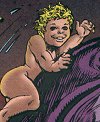
![]() In the end, David finally moves the last pieces into place, setting things up for the appearance of the character we know as Aquaman. And perhaps not coincidentally, setting up the characterisation, sources for much of the supporting cast, and some key conflicts for the Aquaman series he now writes. Also of note is the excellent Tempest limited series written and drawn by Phil Jimenez, which draws upon the history David maps out here.
In the end, David finally moves the last pieces into place, setting things up for the appearance of the character we know as Aquaman. And perhaps not coincidentally, setting up the characterisation, sources for much of the supporting cast, and some key conflicts for the Aquaman series he now writes. Also of note is the excellent Tempest limited series written and drawn by Phil Jimenez, which draws upon the history David maps out here.

![]() One of the strengths that holds this large series together is the art by Esteban Maroto. Despite the large cast of unfamiliar characters, he manages to make each of them easily recognisable, even as they age. In particular, the original king Orin progresses convincingly from young man to elder. The exotic scenery, undersea fauna, and evolving "period" costumes posed a real challenge as well, which Maroto was definitely up to handling.
One of the strengths that holds this large series together is the art by Esteban Maroto. Despite the large cast of unfamiliar characters, he manages to make each of them easily recognisable, even as they age. In particular, the original king Orin progresses convincingly from young man to elder. The exotic scenery, undersea fauna, and evolving "period" costumes posed a real challenge as well, which Maroto was definitely up to handling.
![]() The underwater scenes sometimes look a bit like above-water scenes with fish floating by (in terms of how the characters stand and walk about instead of floating or swimming, and with little regard for how fabric would be affected by water eddies and buoyancy), but that's almost a convention of the underwater-civilisation genre and a major convenience for the artist, so I'm willing to forgive it.
The underwater scenes sometimes look a bit like above-water scenes with fish floating by (in terms of how the characters stand and walk about instead of floating or swimming, and with little regard for how fabric would be affected by water eddies and buoyancy), but that's almost a convention of the underwater-civilisation genre and a major convenience for the artist, so I'm willing to forgive it.
![]() This series is well worth tracking down if you're a fan of the guy who talks to fish, and even if you're not (since he barely appears in it). There's far more palace intrique than superheroics involved, so if your tastes lean exclusively toward the later, you may be bored... or maybe not.
This series is well worth tracking down if you're a fan of the guy who talks to fish, and even if you're not (since he barely appears in it). There's far more palace intrique than superheroics involved, so if your tastes lean exclusively toward the later, you may be bored... or maybe not.
![]()
© Todd VerBeek, Radio ZeroTM